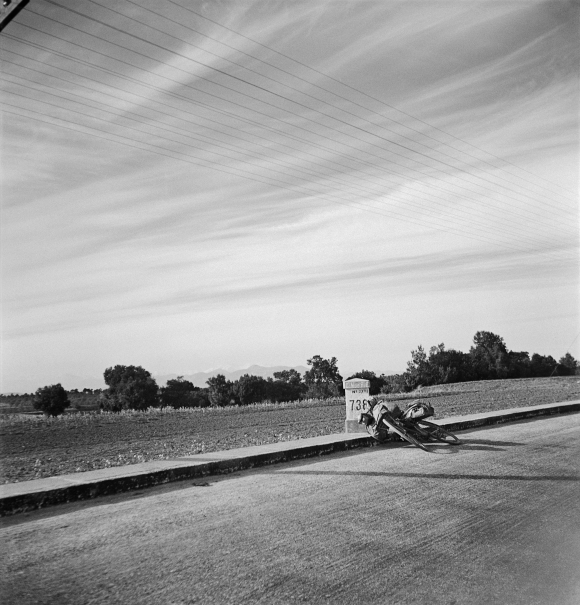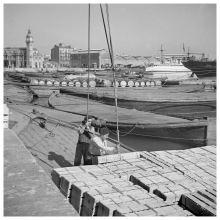In 1935 the photographer Pierre Verger (París 1902 - Salvador de Bahía 1996) went on his bicycle along the Mediterranean coast from Portbou, in the French border, down to Cadiz. Throughout his tour he visited cities like Barcelona, Villareal, Valencia, Alicante, Elche, Lorca, Granada, Almería, Úbeda, Córdoba, Sevilla, Málaga, Arcos de la Frontera and Ronda. His files also reveal he stopped at Madrid, most likely while he was coming back to France.
During his tour Verger spontaneously photographed the strollers he found on his way, the landscapes, the city streets and the daily activities of its inhabitants, the buildings, etc. In his pictures we can recognise, among other spots, Barcelona’s Raval and Rambla, the old San Pascual’s Church in Villareal, Paterna Caves, Valencia’s harbour, the Palm Grove in Elche, San Juan’s Church in Lorca, the Alhambra of Granada, the Royal Tobacco Factory in Sevilla and the Gran Via in Madrid. Likewise, Verger took pictures linked to folklore and tradition. These scenes specially drew the attention of someone who, being meant to be a businessman like his father, rebelled and decided to devote his life to explore the world with a Rolleiflex camera.

Granada. Gitana. 1935. © Fundação Pierre Verger
Pierre Verger had his photographs published in books and reviews such as Paris Match, Paris-Soir, Vu, Regards, Le Petit Journal, Daily Mirror and Life. He worked since 1934 for the Alliance Photo agency, officially founded that same year by Maria Eisner, René Zuber and Pierre Boucher. This agency gathered photographers of the stature of Henri Cartier-Bresson, Robert Capa, Gerda Taro, Denise Bellon or Chim (David Seymour), before they formed in 1947 the Magnum agency. Verger shared space with them in some of the journals published about the Spanish Civil War (1936-1939).
General entry: 2€
Reduced rate: 1€ Free admission at weekends and holidays
In 1933 he travelled to Polynesia in search of an earthly paradise. The previous year he had walked around Corsica with Pierre Boucher who introduced him to the world of photography and developing. In 1934 he went on a tour around the world working as a photo reporter for the newspaper Paris-Soir, a tour of six months where he went across the USA, Japan, China and the Philippines, followed by North and Central Africa – then known as Western French Africa - (1935-1936); Martinique, Guadalupe, Santo Domingo and Cuba (1936); Mexico (1936-1937); China and The Philippines (1937-1938); Indochina (1938); Mexico, Guatemala and Ecuador (1939); Brazil and Argentina (1941-1942); Peru, Bolivia and Brazil (1946).
Throughout all this trip time he interacted with very different people from the art and the anthropology worlds. He was part of the avant-garde poet Jacques Prévert’s entourage and of the theatre company Le Groupe Octobre. He was also involved in the Ethnographic Museum of the Trocadéro in Paris, where he worked as a voluntary collaborator in the photographic laboratory and where he met, among others, Alfred Métraux, Roger Bastide, Gilbert Rouget and Michel Leiris.
After 15 years of trips linked to a travelling and spontaneous practice of photography, Verger arrived in Salvador da Bahia (Brazil) and discovered Afro-Brazilian cultures. A spark which meant a gradual abandonment of photography and a turn to writing and anthropologic research. At the age of 44 he began to study the connections between African and Afro-Brazilian cultures, devoting the rest of his life to this research.



![Valencia [Cuevas de Paterna]. 1935. © Fundação Pierre Verger Valencia [Cuevas de Paterna]. 1935. © Fundação Pierre Verger](http://www.muvim.es/sites/default/files/styles/imagen_cuadrada_85/public/EXPOSICIONS/Verger/4_v55901.png?itok=guQQchXi)
![Valencia [Cuevas de Paterna]. 1935. © Fundação Pierre Verger Valencia [Cuevas de Paterna]. 1935. © Fundação Pierre Verger](http://www.muvim.es/sites/default/files/styles/imagen_cuadrada_85/public/EXPOSICIONS/Verger/6_v55909.png?itok=sK2ERH6B)


![Madrid. [Gran Vía]. 1935. © Fundação Pierre Verger Madrid. [Gran Vía]. 1935. © Fundação Pierre Verger](http://www.muvim.es/sites/default/files/styles/imagen_cuadrada_85/public/EXPOSICIONS/Verger/22_v55575.png?itok=g8NRmic7)


